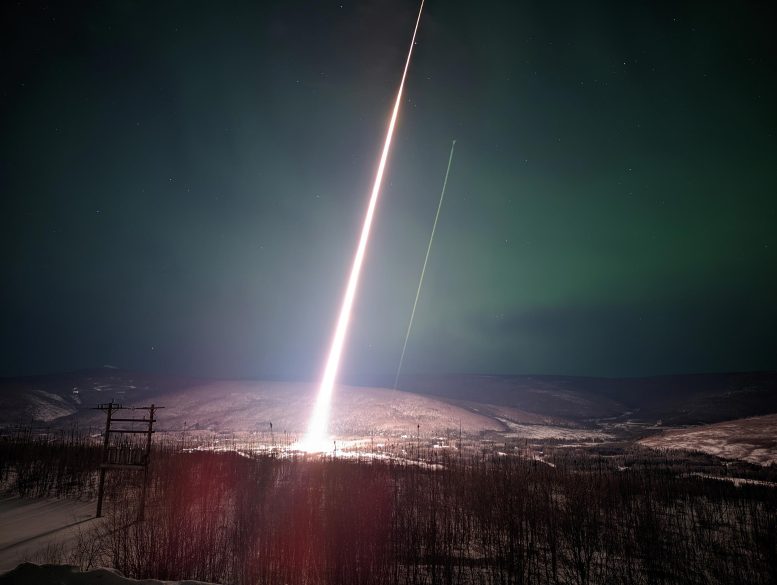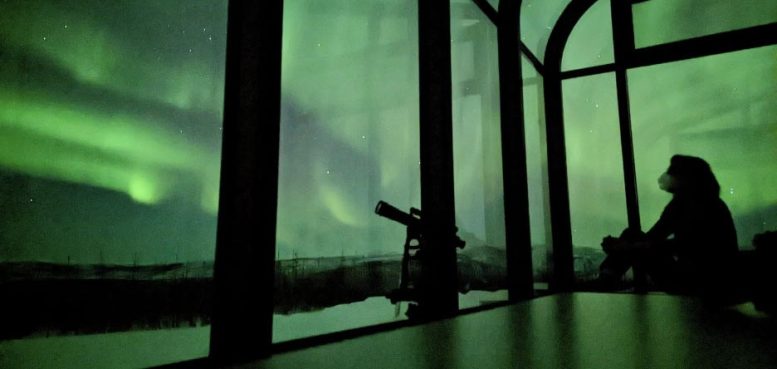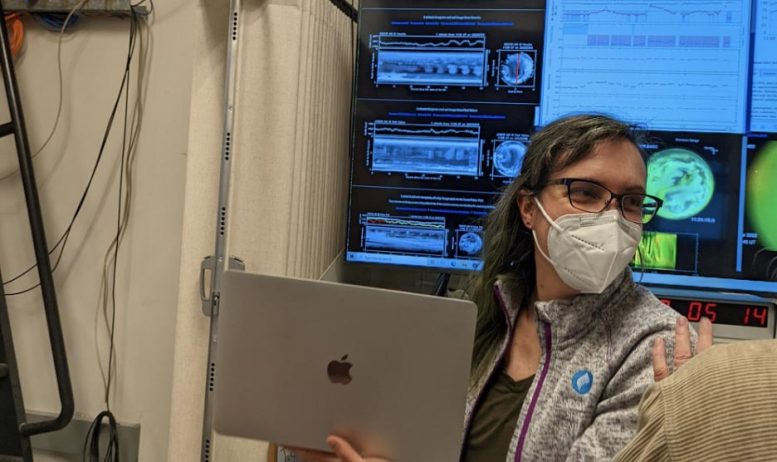This image of a colorful aurora was taken in Delta Junction, Alaska, on April 10, 2015. All auroras are created by energetic electrons, which rain down from Earth’s magnetic bubble and interact with particles in the upper atmosphere to create glowing lights that stretch across the sky. Credit: Image courtesy of Sebastian Saarloos
NASA’s citizen science projects are collaborations between scientists and interested members of the public. Through these collaborations, volunteers known as citizen scientists have helped make thousands of important scientific discoveries. Aurorasaurus is one such project that tracks auroras around the world in real time via reports on its website and on Twitter.
Aurorasaurus often partners with other organizations to complement science with citizen science and recently Aurorasauraus partnered with NASA’s Loss through Auroral Microburst Pulsations (LAMP) mission. Early on the morning of Saturday, March 5, 2022, the LAMP mission successfully took flight, flying straight into a pulsating aurora.
Pulsating auroras are quirky, shy auroral forms. They occur within diffuse auroras, and look like pulsating patches toward the equator that turn on and off every few seconds. They also have irregular shapes that reappear. They usually occur late in the night or early in the morning, after the main arcs have subsided. They dance often but are less frequently caught on camera due to their dimness and timing. Because auroras reveal invisible structures and pulsating auroras are caused by electrons with huge amounts of energy, pulsating auroras are important for studying how our planet gets energy from space.
The LAMP team included several of Aurorasaurs’ superuser group, the Aurorasaurus Ambassadors, who were excited to work together on a citizen science campaign around the mission. As part of the citizen science collaboration, the Aurorasaurus and LAMP teams asked for citizen scientists’ questions about pulsating aurora. Here are their answers.
What is the difference between the aurora that looks like a curtain and that which just looks like a fuzzy patch or cloud in the sky?
Auroras that look like curtains are called “discrete auroras,” and auroras that look like a fuzzy patch or cloud are called “diffuse auroras.” There’s a lot of science that goes into which makes an appearance at what time of night, and it can differ depending on your location.
If you are watching from the auroras’ usual location at high latitudes—for example, from Fairbanks, Alaska, or Reykjavik, Iceland—you can see auroras caused by geomagnetic storms, which are caused by intense storms of particles and energy from the Sun. But more commonly you’ll see regular, smaller “auroral substorms.” These are caused by a different process. Both diffuse and discrete auroras happen as part of the natural progression of the more common process called a substorm.
If you are watching from mid-latitudes like North Dakota or southern Alberta, the aurora you see will likely be caused by a geomagnetic storm. Stronger storms generate both types of aurora and tend to push the auroras further down toward the equator.
Is it normal to have pulsating aurora and other kinds of aurora in the sky together?
Yes, it is very common for pulsating aurora to appear alongside other types. Depending on your location, you might see part or all of the sky pulsating. Much like discrete auroras, pulsating auroras fan out across great distances and are visible from different perspectives, based on your location. You could even find yourself in a special location where, in addition to pulsating auroras, you can see discrete aurora evolving to the north and diffuse aurora pulsing to the south, with a distinct edge between the two.
There are also many different sub-types of pulsating aurora. Some form shapes that hold their edges like a patch turning on and off, while some “whoosh” on and off in curling, dragonlike shapes. Another type of aurora forms shapes that are unusually flat, like pancakes in the sky. Seeing one of these types might mean that there’s some interesting science going on in the Earth’s ionized upper atmosphere, or in the way particles rain down from space. Citizen scientists’ photos of these displays from multiple locations may help scientists find more clues to the mystery of how they occur.
I am curious about the speed of the pulsating aurora and what makes it dance so fast. It is almost like being in an outdoor nightclub!
Pulsating auroras can dance slowly or quickly, and can flash both pink and green. They can especially give a nightclub effect when multiple things are happening at once. Here are two factors that contribute to the lights turning on and off, which is a time-based or “temporal” effect.
- Pulsating auroras we think are caused by special waves called “chorus waves” interacting with particles in near-Earth space. The waves can give the particles energy, bouncing them into the atmosphere. The frequency of groups of chorus waves is the frequency at which the particles are being thrown into the upper atmosphere, and therefore the frequency of the patchy pulsations that you see. Sometimes, there are even higher-speed variations embedded in the light that are not visible to the naked eye or regular cameras.
- Extra-fast, pink flashes are caused by the chemistry of nitrogen gas. The colors of aurora are made when atoms and molecules in the upper atmosphere are energized and then release that extra energy as light. Different gases make different colors, and the release process happens at different speeds for different kinds. Nitrogen, which makes a pink color, emits light very quickly—faster than oxygen green—so the pink appears to move faster.
Put these together and you can get brilliant, rapid displays!
Can I see pulsating aurora in Washington state?
Yes, pulsating aurora may occur at mid-latitudes during larger geomagnetic storms. Keep an eye on Aurorasaurus and our Storm Tracker chart to help track auroral activity. And if you see pulsating aurora, you can make a citizen science report to Aurorasaurus! Pulsating auroras can be enormous, and cover hundreds of miles, so the more locations they are reported from, the more our scientific understanding can grow. The project is grateful to all those who submitted reports during the LAMP mission campaign.
Why is it important to send instruments above the pulsating aurora to measure it? What things can’t be measured from the ground or satellites?
While satellites and ground-based observations can capture some aspects, we can gain a better picture of the cause of auroral dynamics by collecting particles within or very near to the aurora. To do this, scientists send instruments to collect data at and just above the location of the aurora, using a special type of rocket known as a sounding rocket, which can fly into auroras.
Sounding rockets provide a unique way to capture data about the aurora in situ in regions that are otherwise hard to sample. Sounding rockets also move more slowly than satellites, so they can better capture rapidly-moving phenomena like auroras in exquisite detail. This can help scientists learn more about “microphysics,” the physics of waves interacting with tiny, charged particles. On March 5, 2022, a sounding rocket launched LAMP to about 267 miles up where it flew through a pulsating aurora.
On March 5, 2022, a sounding rocket launched LAMP to about 267 miles up where it flew through a pulsating aurora. In addition, LAMP also had two cameras on board to take photos of the aurora, from a Japanese team including members from JAXA, Nagoya University, Tohoku University, Kyushu Institute of Technology, and the University of Electro-Communications. Because the rocket itself rotates about once per second, the cameras were mounted on a “de-spun” platform. The platform rotates in the opposite direction of the rocket at the same rate as it spins, so the cameras can stay relatively still and take clear pictures. The camera provided real-time still images of the pulsating patches to the scientists on the ground. This was the first time that a camera with a de-spun platform mounted to a rocket has been successfully demonstrated!
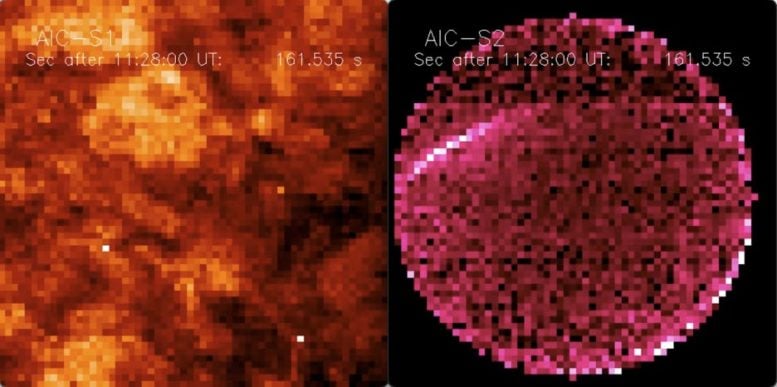
Simultaneous images of pulsating aurora from the two cameras attached to LAMP. Credit: AIC-S1/AIC-S2 team
Has rocket citizen science been done before?
Yes! Aurorasaurus helped connect two-woman citizen science team Hearts in the Ice with a rocket mission in Norway during their time overwintering in Svalbard. Read more here.
What’s it like to help with a mission like this?
Pretty amazing, according to Aurorasaurus Ambassador and senior undergraduate student at the University of North Dakota,Vincent Ledvina, who helped with the launch:
I just got back from Fort Yukon, Alaska, where Aurorasaurus helped connect me with an opportunity to assist with the NASA LAMP sounding rocket mission. It was eye-opening and rewarding to watch the team effort, and I am grateful to Aurorasaurus and the LAMP team for opening this door to me. Seeing all the moving parts (literally and figuratively) that have to come together in order for the mission to be a success makes me realize how important communication and leadership are in science. Logistics in remote areas is a challenge I never fully realized until this mission. Although I was staying at an Air Force station, I only had access to a low-bandwidth satellite internet connection with no cell service, so the most reliable communication was a landline phone that looked straight from the 1980s!
While I had some sense of how aurora cameras work from the North Dakota Dual Auroral Camera (NoDDAC) project, I finally got a taste of what real science-grade cameras are like. My job was to make sure three special cameras — some of which were from the Japanese rocket team — were running when the LAMP rocket launched, to capture video of pulsating aurora. The video will be correlated with data the rocket gathered as it flew through the aurora.
An avid photographer himself, Vincent Ledvina took 40,000 of his own images during the trip and made this beautiful compilation.
Pulsating aurora is a fascinating and mysterious phenomenon, and Auroasaurus looks forward to seeing what the data gathered by LAMP will reveal. They are grateful to all the citizen scientists who sent in questions—especially Michelle and Tracy—submitted photos of pulsating aurora, and shared info about the mission! Thank you for your interest and contributions.
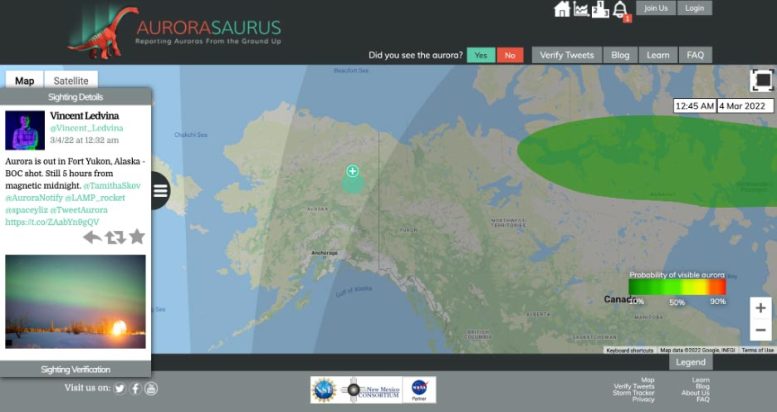
Report from Aurorasaurus website.



